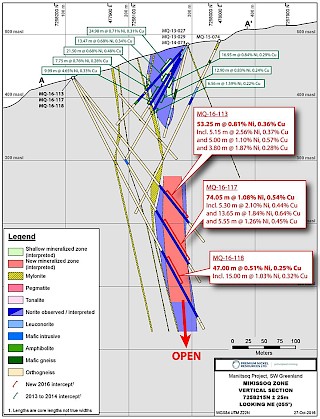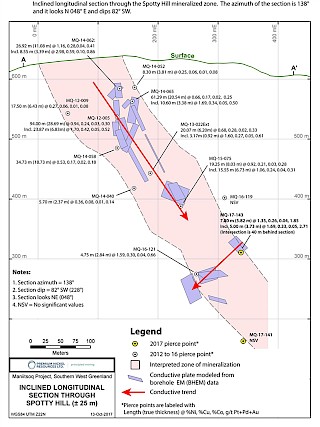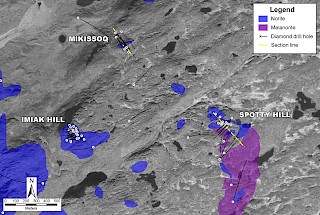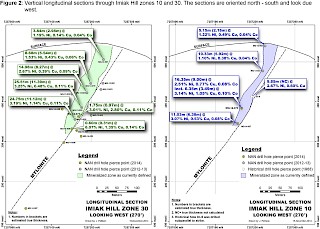Exploration programs on the Maniitsoq Property were completed between 2011 and 2018. The exploration work expanded the footprint of the historic mineral occurrences at the Imiak Hill Complex and Fossilik and resulted in the discovery of several new occurrences of mineralized norite in the belt.
Imiak Hill Complex (IHC)
The Imiak Hill Complex comprises three separate mineralized norite intrusions termed Imiak Hill, Spotty Hill and Mikissoq within an ~3km2 area of the Maniitsoq property (figure 5)
Imiak Hill

The up-dip extent of the Imiak Hill mineralization, originally discovered by (KØ), is marked by a surface gossan approximately 80 by 100 metres in size which has a strong VTEM conductivity signal. Mineralization consists of two parallel zones, defined over a maximum strike length of 25 to 30 metres and dip extent of 270 meters. Mineralization is hosted in norite and leuconorite and consists of a network of remobilized semi-massive to massive sulphide veins and breccia veins collectively ranging from approximately 0.3 to 13.6 metres in width. Mineralization increases in grade with depth and sulphides consist of medium to coarse grained pyrrhotite, pentlandite, pyrite, and chalcopyrite. Semi-massive to massive sulphide samples typically grade 3 to 7 % Ni, 0.1 to 0.2 % Co and less than 0.1 g/t Pt+Pd+Au. Copper values are highly variable ranging from less than 0.1 to 6.3 percent; this broad range suggests that secondary re-distribution of mineralization into noritic rocks has occurred.
The mineral zone at Imiak is closed-off by exploration, but it remains possible that structurally detached segments of the norite may exist at depth.
Assays highlights include:
- MQ-13-026: 25.51 m @ 3.25% Ni, 0.48% Cu
- MQ-13-028: 24.75 m @ 3.19% Ni, 1.14% Cu
- MQ-14-072: 16.35 m @ 2.51% Ni, 0.77% Cu
Mikissoq

Following the recognition of strong conductivity in the VTEM survey coincident with the historic Mikissoq gossan containing up to 3.73% Ni in surface grab samples, The Company completed drilling on the target.
Mineralization at Mikissoq is hosted in two norite intrusions separated by orthogneiss. The mineralization in the upper and deeper norite bodies are interpreted to strike 58 degrees with dips of 78 degrees and 89 degrees to the southeast, respectively.
The shallow mineralization has been intersected over a strike extent of 25 metres and to a maximum depth of 95 metres below surface. Intersections range from 2 to 20 metres in width. Mineralization consists of disseminated to blebby sulphides with intervals of locally remobilized vein, stringer, and breccia vein sulphides, as well as sulphide fracture fillings. The fracture fillings and breccia textures, consisting of sulphides wrapping around clasts of norite, indicate that the magmatic sulphide mineralization has undergone brittle deformation as well as sulphide remobilization. Assay values for the shallow mineralization vary widely depending on the amount of remobilized sulphides present in the sample. Semi-massive to massive sulphide samples from borehole MQ-13-029 returned values of approximately 4.5 to 7.5 % Ni, 0.15 to 0.65 % Cu, 0.1 to 0.2 % Co and up to 0.3 g/t Pt+Pd+Au. Disseminated sulphide mineralization with localized sulphide veins and stringers in borehole MQ-13-027 returned an average value of 0.7 % Ni and 0.3 % Cu.
The top of the deeper sulphide zone is located approximately 100 metres below the bottom edge of the shallow mineralization and has been intersected over a dip extent of 105 metres by three boreholes on one section. Intersections range from 21 to 38 meters in true width. The mineralization consists of coarse-grained magmatic sulphide disseminations, blebs, and patches, with local stringers and veins of remobilized sulphide mineralization. The deeper sulphide lens averages between 0.5 and 1.1 % Ni, 0.25 and 0.55 % Cu, and 0.01 and 0.03 % Co. The intervals with the highest sulphide content, including remobilized sulphides, typically grade between 1 and 4 % Ni, 0.25 and 0.65 % Cu, as well as 0.02 and 0.08 % Co. Combined Pt+Pd+Au concentrations are typically less than 0.2 g/t.
The trend of the Mikissoq mineral zone is open and untested at depth.
Assay highlights include:
Upper Zone
- MQ-13-029: 9.99 m @ 4.65% Ni, 0.33% Cu
- MQ-14-073: 61.35 m @ 0.63% Ni, 0.18% Cu incl.
- 2.6 m @ 1.79% Ni and 0.54% Cu and
- 4.6 m @ 1.27% Ni and 0.27% Cu and




